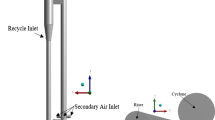Abstract
According to the recently developed single-trough floating machine with the world’s largest volume (inflatable mechanical agitation flotation machine with volume of 320 m3) in China, the gas-fluid two-phase flow in flotation cell was simulated using computational fluid dynamics method. It is shown that hexahedral mesh scheme is more suitable for the complex structure of the flotation cell than tetrahedral mesh scheme, and a mesh quality ranging from 0.7 to 1.0 is obtained. Comparative studies of the standard k-ε, k-ω and realizable k-ε turbulence models were carried out. It is indicated that the standard k-ε turbulence model could give a result relatively close to the practice and the liquid phase flow field is well characterized. In addition, two obvious recirculation zones are formed in the mixing zones, and the pressure on the rotor and stator is well characterized. Furthermore, the simulation results using improved standard k-ε turbulence model show that surface tension coefficient of 0.072, drag model of Grace and coefficient of 4, and lift coefficient of 0.001 can be achieved. The research results suggest that gas-fluid two-phase flow in large flotation cell can be well simulated using computational fluid dynamics method.
Similar content being viewed by others
References
AHMED N, JAMESON G J. The effect of bubble size on the rate of flotation of fine particles [J]. International Journal of Mineral Processing, 1985, 14(3): 195–215.
GIRGIN E H, DO S, GOMEZ C O, FINCH J A. Bubble size as a function of impeller speed in a self-aeration laboratory flotation cell [J]. Minerals Engineering, 2006, 19(2): 201–203.
KOH P T L, SCHWARZ M P. CFD modeling of bubble–particle collision rates and efficiencies in a flotation cell [J]. Minerals Engineering 2003, 16(11): 1055–1059.
KOH P T L, SCHWARZ M P. CFD modeling of bubble–particle attachments in flotation cells [J]. Minerals Engineering, 2006, 19(6/7/8): 619–626.
RIELLY C D, EVANS G M, DAVIDSON J F, CARPENTER K J. Effect of vessel scaleup on the hydrodynamics of a self-aerating concave blade impeller [J]. Chemical Engineering Science, 1992, 47(13/14): 3395–3402.
KOH P T L, SCHWARZ M P. CFD model of a self-aerating flotation cell [J]. International Journal of Mineral Processing [J]. 2007, 85(1/2/3): 16–24.
WEBER A, MEADOWS D, VILLANUEVA F, PALOMO R, PRADO S. Development of the world’s largest flotation machine [C]//Centenary of Flotation Symposium. Brisbane, 2005: 285–291.
YIANATOS J B, MOYS M H, CONTRERAS F, VILLANUEVA A. Froth recovery of industrial flotation cells [J]. Minerals Engineering, 2008, 21(12/13/14): 817–825.
SHEN Zheng-chang. Research and design of 200 m3 air forced flotation machine [J]. Nonferrous Metals, 2009, 61(2): 100–103. (in Chinese)
SHEN Zheng-chang. Research on the design and processing characteristics of 320 m3 air-forced mechanical flotation cell [C]//Proceedings of 7th Academic Conference of Chemical, Metallurgy and Material Engineering Department. Chinese Academy of Engineering, Beijing, 2009, 10: 788–793. (in Chinese)
YIANATOS J B, BERGH L G, AGUILERA J. Flotation scale up: use of separability curves [J]. Minerals Engineering, 2003, 6(4): 347–352.
ARBITER N. Development and scale-up of large flotation cells [J]. Minerals Engineering, 2000, 52(3): 28–33.
YIANATOS J B, HENRIQUEZ F H, OROZ A G. Characterization of large size flotation cells [J], Minerals Engineering, 2006, 19(6/7/8): 531–538.
XIA J L, RINNE A, GRÖNSTRAND S. Effect of turbulence models on prediction of fluid flow in an Outotec flotation cell [J]. Minerals Engineering, 2009, 22(11): 880–885.
CHU K W, WANG B, YU A B, VINCE A, BARNETT G D, BARNETT P J. CFD–DEM study of the effect of particle density distribution on the multiphase flow and performance of dense medium cyclone [J]. Minerals Engineering, 2009, 22(11): 893–909.
JAVASUNDARA C T, YANG R Y, GUO B Y, YU A B, RUBENSTEIN J. Effect of slurry properties on particle motion in IsaMills [J]. Minerals Engineering, 2009, 22(11): 886–892.
CHU K W, YU A B. Numerical simulation of complex particle–fluid flows [J]. Powder Technology, 2008, 179(3):104–114.
KARAGOZ I, KAVA F. CFD investigation of the flow and heat transfer characteristics in a tangential inlet cyclone [J]. International Communications in Heat and Mass Transfer, 2007, 34(9/10): 1119–1126.
RAOUFI A, SHAMS M, KANANI H. CFD analysis of flow field in square cyclones [J]. Powder Technology, 2009, 191(3): 349–357.
SHUKLA K S, SHUKLA P, GHOSH P. The effect of modeling of velocity fluctuations on prediction of collection efficiency of cyclone separators [J]. Applied Mathematical Modeling, 2013, 37(8): 5774–5789.
KIM D, STOESSER T, KIM J H. Modeling aspects of flow and solute transport simulations in water disinfection tanks [J]. Applied Mathematical Modeling, 2013, 37(16/17): 8039–8050.
WANG Shuai, LU Huang, GAO Jian-min, LU Hui-lin, LIU Guo-dong, XU Peng-fei, HE Yu-rong. CFD simulation of gas–solid flow with a cluster structure-dependent drag coefficient model in circulating fluidized beds [J]. Applied Mathematical Modeling, 2013, 37(16/17): 8179–8202.
TOMINAGA Y, STATHOPOULOS T. CFD simulation of near-field pollutant dispersion in the urban environment: A review of current modeling techniques [J]. Atmospheric Environment, 2013, 79: 716–730.
Author information
Authors and Affiliations
Corresponding author
Additional information
Foundation item: Project(51074027) supported by the National Natural Science Foundation of China
Rights and permissions
About this article
Cite this article
Shen, Zc., Chen, Jh., Zhang, Ch. et al. Computational fluid dynamics simulation of gas-liquid two phases flow in 320 m3 air-blowing mechanical flotation cell using different turbulence models. J. Cent. South Univ. 22, 2385–2392 (2015). https://doi.org/10.1007/s11771-015-2764-7
Received:
Accepted:
Published:
Issue Date:
DOI: https://doi.org/10.1007/s11771-015-2764-7




